It is known that Italian museums abound with masterpieces of Flemish Renaissance art. But if one wanted to get to know the Flemish Renaissance in the land of its origin, Flanders, what could be the stops to see the places of the great masters up close, to observe their masterpieces, to walk through the sites where the masterpieces made specifically for those buildings still stand? So we have come up with a Flanders travel itinerary that touches on ten stops in five cities, starting with the two largest, Bruges and Ghent, touching on the sites of Mechelen and Leuven, and finally concluding in the capital Brussels (or Brussels, if you use the Flemish name). Enjoy your trip!
1. Bruges, Groeninge Museum
The Groeningemuseum allows you to begin familiarizing yourself with Flemish Renaissance painting, and is therefore an essential stop on a journey to discover the Renaissance in Flanders. The institute was founded between 1929 and 1930, in a small building housing a vast collection of Belgian (but not only) art and Flemish art, covering a time span from the 15th century to the present day. Here, you will find the two masterpieces of Jan van Eyck (Maaseik, c. 1390 - Bruges, 1441) in Bruges: the Madonna of Canon Van der Paele, from 1436(at this link you can read an in-depth discussion of the work written by Till-Holger Borchert, one of Van Eyck’s leading experts), and the Portrait of Margaret van Eyck, wife of the artist, from 1439. And still remaining in the fifteenth century, the Groeningemuseum houses a masterpiece by Hugo van der Goes (Ghent, c. 1430/1440 - Auderghem, 1482), the Death of the Virgin, and the itinerary is completed with works by other important authors such as Dirk Bouts (Haarlem, c. 1415 - Leuven, 1475) and Hans Memling (Seligenstadt, c. 1436 - Bruges, 1494): by the latter, German by nationality but Flemish by culture, the Groeningemuseum houses the Moreel Family Triptych, a masterpiece from 1484. Finally, although he was not Flemish, an important work by the Dutchman Jheronimus Bosch (Jeroen Anthoniszoon van Aken; ’s-Hertogenbosch, 1453 - 1516), the Triptych of the Judgment of Bruges, is located here.
 |
| Van Eyck’s works at the Groeninge Museum. Ph. Credit Sarah Bauwens |
2. Bruges, Gruuthuse Museum
The “Palace of Wonders” was reopened in May 2019 after five years of construction. It is a building that was built in the 15th century by the merchant and patron Lodewijk van Gruuthuse (“Gruuthuse” literally means “house of Gruut”: in fact, the family held a monopoly on gruut, a mixture of spices used to flavor beer), and which now houses the museum that tells the story of the city to the present day. The building represents one of the main masterpieces of Flemish Renaissance architecture, but the interior is also of great value: in particular, the chapel, also commissioned by Lodewijk van Gruuthuse and commissioned in 1472, is worth seeing. The chapel moreover allows a view of the Church of Our Lady (Onze-Lieve-Vrouwekerk), where Michelangelo’s extraordinary Madonna and Child, carved around 1504, is kept.
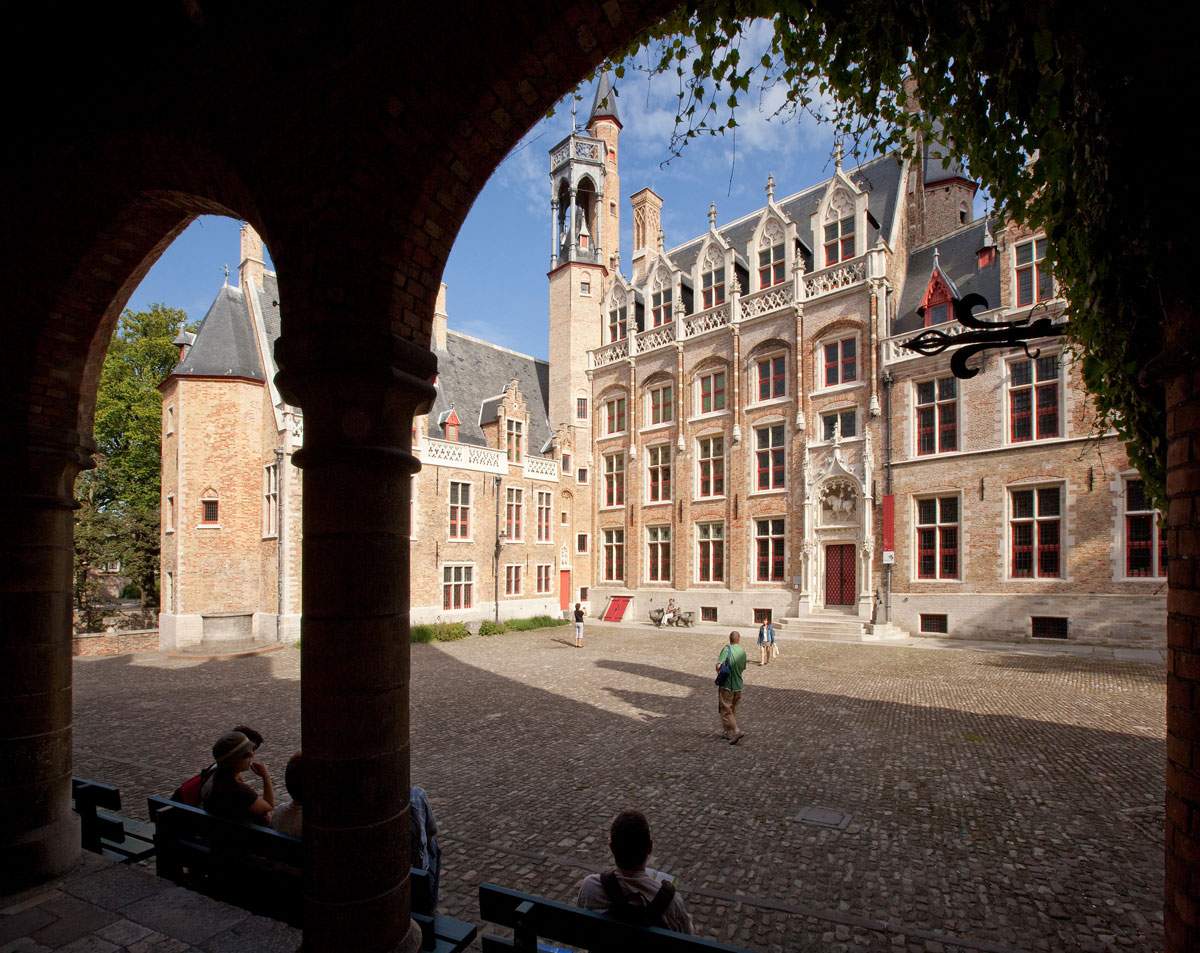 |
| The Gruuthuse Museum in Bruges |
3. Bruges, Sint-Janshospitaal - Memling Museum.
The Sint-Janshospitaal, or St. John’s Hospital, is one of the oldest hospitals in Europe: in fact, it was founded around 1150 and during the Middle Ages was a place intended to receive both the sick and pilgrims (as was the case in many similar facilities around the continent). It remained in operation until the end of the 19th century and is now home to the Memling Museum, an institution that houses six important works by Hans Memling, including the large Triptych of St. John the Baptist and St. John the Evangelist as well as the Triptych of the Mystic Marriage of St. Catherine of Alexandria and the Reliquary of St. Ursula, commissioned by the hospital itself. The hospital also provides insight into how life was conducted at the time, since many ancient objects are preserved there that tell the story of hospital life in the Renaissance (but also before). Together with the Groeningemuseum and the Gruuthuse Museum, the Memling Museum forms the Bruges civic museum system.
 |
| The Memling Museum in Bruges |
4. Bruges, Cathedral of St. Savior and St. Donazian
The Sint-Salvatorskathedraal is the main building of worship in Bruges, and although the dedication to Christ the Savior and St. Donazian of Rheims dates back to the 19th century, its origins are very ancient: the present temple was built in 1250 and finished a century later, on the remains of an earlier Romanesque building destroyed by fire, itself built on top of a 9th-century church (which replaced a 7th-century church). Its present appearance is Gothic from work undertaken between the 13th and 14th centuries, which was followed between 1480 and 1550 by an extension designed by Jan van den Poele. The church houses a masterpiece of the Flemish Renaissance, the Triptych of St. Hippolytus by Dirk Bouts from 1464. A short distance from the Cathedral is the Prinsenhof (now a luxury hotel), the former residence of the Dukes of Burgundy: for them, van Eyck designed a map of the world that may have hung in the palace.
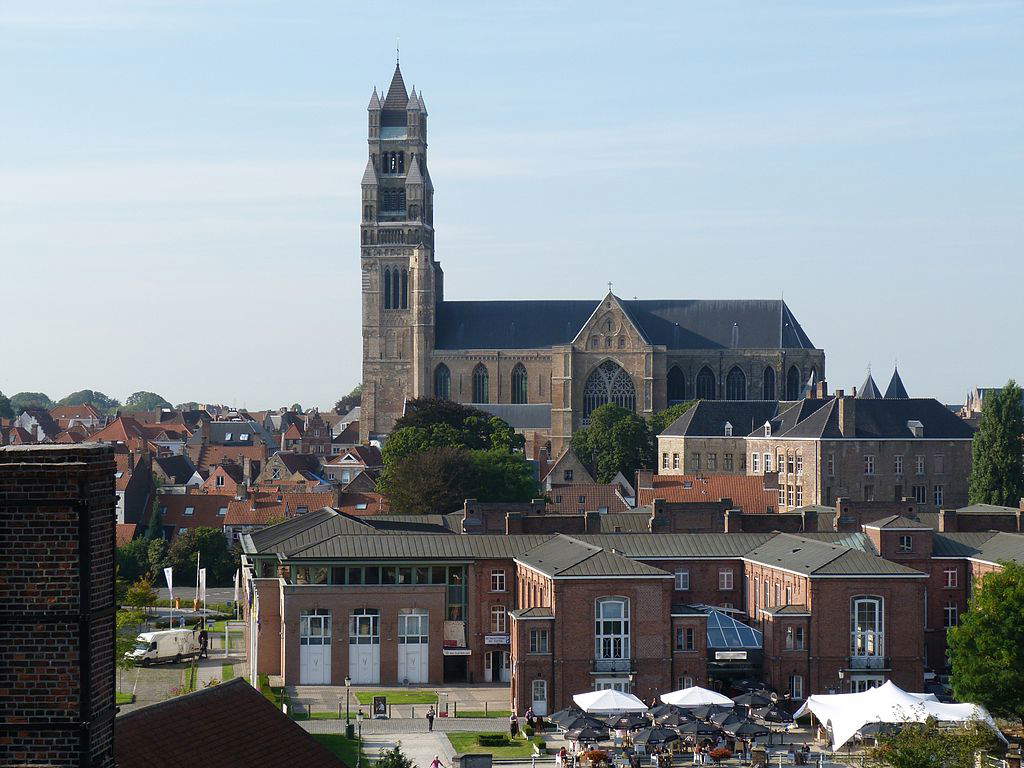 |
| St. Savior’s Cathedral. Ph. Credit Michiel Dumon |
5. Ghent, Cathedral of St. Bavon
It is world-renowned as the home of the Polyptych of the Mystic Lamb, the largest work by Jan van Eyck, executed with his brother Hubert (? - Ghent, 1426), and recently restored (read our focus on the restoration). The work is dated 1432, but it is not the only masterpiece to be found in the Sint-Baafskathedraal, Gent Cathedral, built from 1228 in the Gothic style in place of the earlier Romanesque church (traces of which remain today in the crypt). The cathedral also houses the Calvary Triptych attributed to Justus of Ghent (Joos van Wassenhove; Ghent, c. 1430- c. 1480), a painter who was also active in Italy, in Urbino, at the court of Federico da Montefeltro, and the cathedral’s treasure collection, with numerous pieces from the 15th and Ciqnuecento periods.
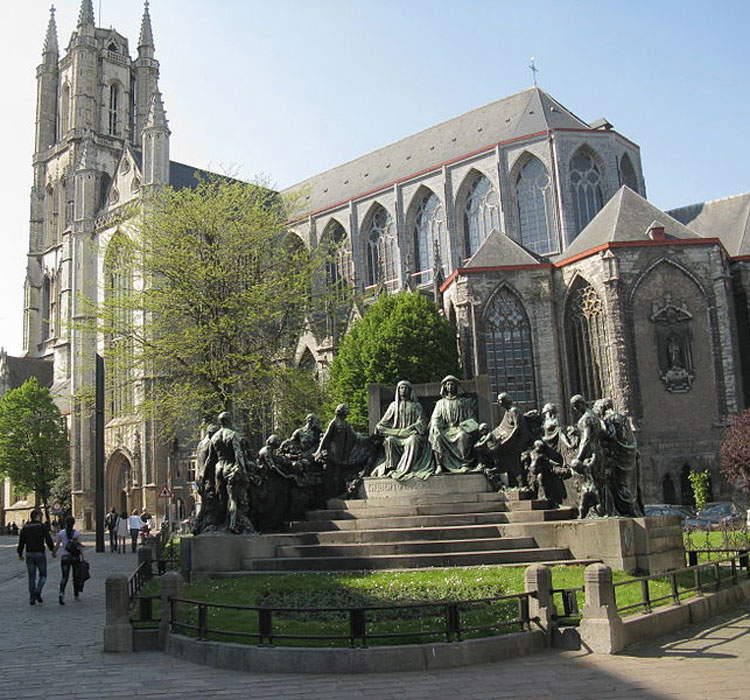 |
| The Cathedral of St. Bavon, high altar |
6. Ghent, Museum voor Schone Kunsten
The MSK is the Museum of Fine Arts in Ghent, capital of East Flanders, the former capital of the region, and the third largest city in Belgium after the capital Brussels and the port city of Antwerp. Designed in the Classical style by architect Charles van Rysselberghe in the late 19th and early 20th centuries, the museum is located near the Citadel Park, was reopened in 2007 after four years of restoration and rearrangement work, and houses a rich collection of Belgian (and other) art from the Middle Ages through the first half of the 20th century. Nine thousand works are housed in the museum: of these, six hundred are on display. Numerous works of the Flemish Renaissance can be encountered here: among the masterpieces are the dramatic Vir dolorum by Robert Campin (Valenciennes, 1378/1379 - Tournai, 1444), and the tender Madonna of the Carnation by Rogier van der Weyden (Tournai, c. 1399 - Brussels, 1464). This museum also holds a painting by the Dutchman Bosch: the St. Jerome painted around 1485.
 |
| A room at the Museum voor Schone Kunsten in Ghent. |
7. Mechelen, Hof van Busleyden
In the early 16th century, the city of Mechelen, an important center in the province of Antwerp, was chosen by Margaret of Austria (governor of the Netherlands between 1506 and 1530) as her home, making it the de facto state capital. Before that, in 1474, Charles the Bold, Duke of Burgundy, made it the capital of the Burgundian Netherlands. Between the fifteenth and sixteenth centuries, then, Mechelen experienced its heyday: evidence of the period is the Hof van Busleyden, the city’s main Renaissance palace, which came into being as the residence of the humanist and patron Hieronymus van Busleyden (Arlon, 1470 - Bordeaux, 1517) and was frequented by artists, men of letters, politicians, humanists, and scientists. Today, the Hof van Busleyden in Mechelen is a rich museum that traces the history of the city also making use of ancient works of art.
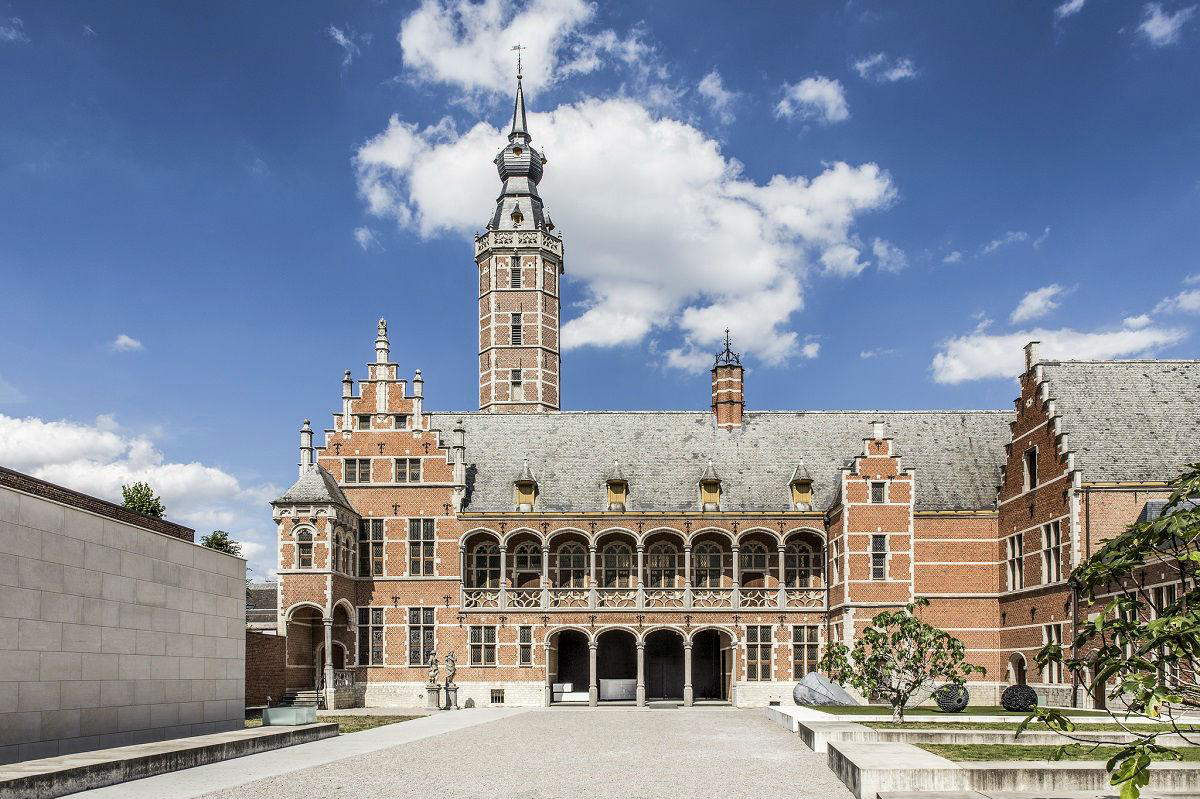 |
| The Hof van Busleyden in Mechelen |
8. Leuven, Collegiate Church of St. Peter
Leuven (Leuven in Flemish) is the capital of Flemish Brabant, and is located a short distance from Brussels. St. Peter’s Collegiate Church is located on the centrally located Grote Markt, the old market square (as well as the city’s main square), and is one of the masterpieces of Brabant Gothic: it was built beginning in 1425 to designs by Jan II Keldermans and Matthijs de Layens. The church houses the masterpieces of Dirk Bouts: in particular, one can admire here the Triptych of the Supper (1464-1468), one of his most important works, and the Triptych of St. Erasmus, from 1465. An early (15th-century) copy of Rogier van der Weyden’s celebrated Deposition (it is kept at the Prado in Madrid), executed by the so-called Master of the Edelheere Triptych, can also be admired inside.
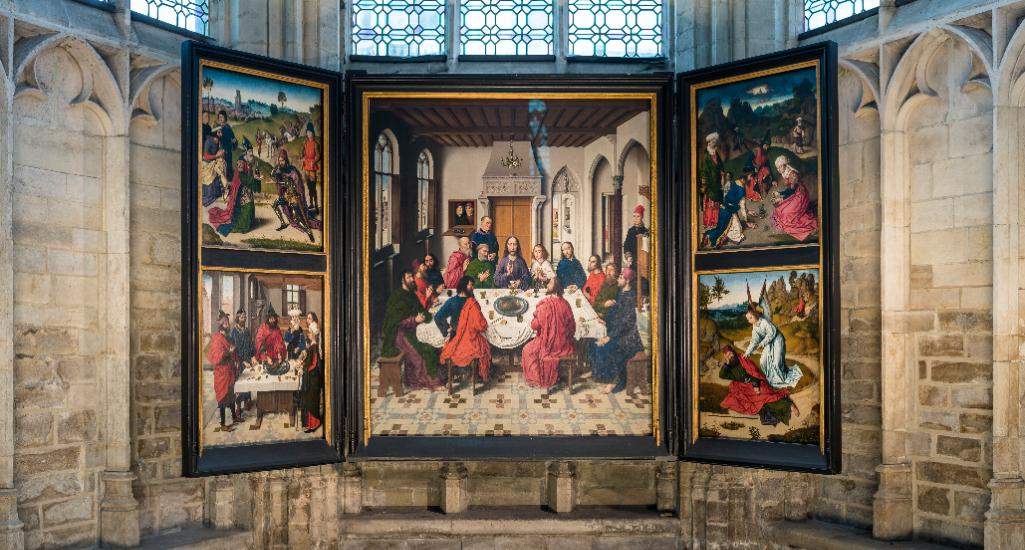 |
| Dirk Bouts’ Triptych of the Supper in St. Peter’s Church in Leuven. |
9. Leuven, M-Museum
The building that houses the M-Museum in Leuven is brand new: in fact, it was built in 2009 designed by architect Stéphane Beel, but the museum’s history is not recent. In fact, the first museum in the city of Leuven was established in 1823, and was housed in the local town hall. About a hundred years later, in 1917, the city collection was moved to what was once the residence of Mayor Leopold Van der Kelen (renovated for the occasion) in the city center. Today, the new location has made it possible to greatly expand the space devoted to the collection. Indeed, the museum’s collection consists of more than fifty thousand objects that tell the story of Leuven and Brabant from the Middle Ages to the 20th century (with, in addition, a new section of contemporary art). There are many works by Flemish Renaissance artists: masterpieces by Dirk Bouts, Rogier van der Weyden, Jan Rombouts, and many others can be found there.
 |
| Leuven, M-Museum |
10. Brussels, De Librije Museum.
A brand new museum that was scheduled to open on May 14, 2020 in the Bibliothèque Royale de Belgique, but will slip due to the ongoing emergency. The museum will reconstruct the history of culture in medieval Europe focusing, of course, on the history of the Belgian capital’s library. The “Librije” (“Library” in Dutch) was the ancient library collection founded at the end of the 14th century by Philip II the Ardite, Duke of Burgundy, and thought to be the largest collection of books in the Burgundian Netherlands. It was in all likelihood one of the largest book collections of its time: as many as 280 manuscripts from that period are preserved today in the Bibliothèque Royale. Then there are illuminated manuscripts representing masterpieces of the Flemish and French miniature of the fifteenth century, fine works by masters such as Willem Vrelant, Loyset Liédet, Philippe de Mazerolles, Simon Marmion, and Lieven van Lathem, who had nothing to envy to the most distinguished masters of painting of their contemporaries.
 |
| The sixteenth-century Nassau Chapel in the Bibliothèque Royale de Belgique |
 |
| Getting to know the Flemish Renaissance... in Flanders: a journey in ten stages |
Warning: the translation into English of the original Italian article was created using automatic tools. We undertake to review all articles, but we do not guarantee the total absence of inaccuracies in the translation due to the program. You can find the original by clicking on the ITA button. If you find any mistake,please contact us.